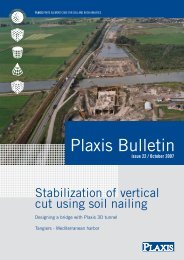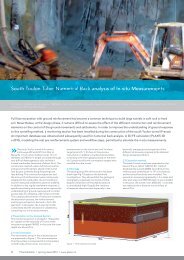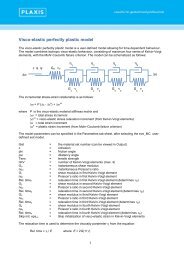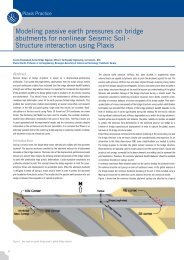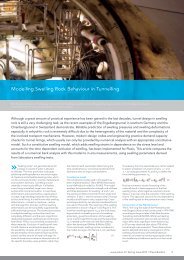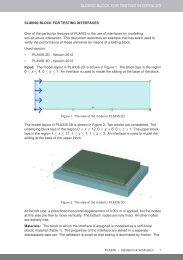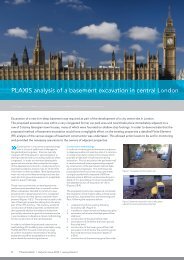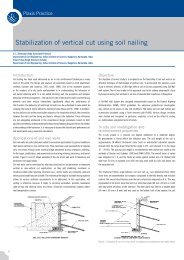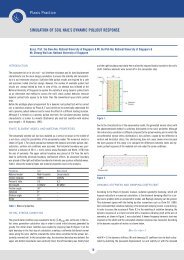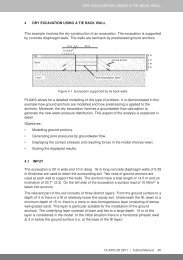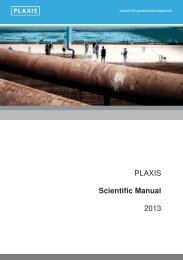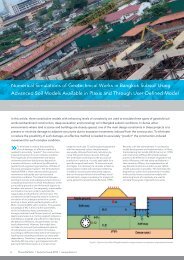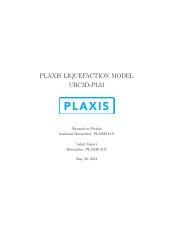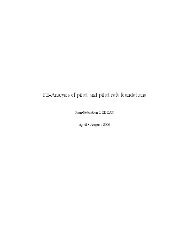Iss26 Art2 - Local Ice Chrushing Analysis of Pile Wall.pdf - Plaxis
Iss26 Art2 - Local Ice Chrushing Analysis of Pile Wall.pdf - Plaxis
Iss26 Art2 - Local Ice Chrushing Analysis of Pile Wall.pdf - Plaxis
- No tags were found...
Create successful ePaper yourself
Turn your PDF publications into a flip-book with our unique Google optimized e-Paper software.
<strong>Plaxis</strong> practice: <strong>Local</strong> ice crushing analyses <strong>of</strong> OPEN CELL SHEET PILE® <strong>Wall</strong> by 3DFoundation<strong>Plaxis</strong> Practice: Simulation <strong>of</strong> Soil Nail Structures using PLAXIS 2DFigure 7. Soil Failure Surface at Failure-Total Incremental Deformation (200 psi with 100 ft2 contact area @ Elevation +4.5 feet)degrees, respectively. Results from this revisedanalysis are presented in Table 4 and indicatedpositive behavior. Figure 9 also depicts the totalincremental soil deformation contours associatedwith the analysis.Discussion and conclusionsPLAXIS 3DFoundation provides a very usefultool for analyzing the performance <strong>of</strong> an OPENCELL SHEET PILE wall system under localizedice impact. The initial ice crushing analysesindicated that ice crushing loads on the sheetpile wall exceeded the strength capacity <strong>of</strong> thethawed granular fill soil and sheet piles alone.Subsequent analyses utilizing soil reinforcementwas found to provide greater resistance andstructural integrity within the failure zone andprovided positive results. Shear strain analysesin <strong>Plaxis</strong> showed that the proposed jet groutingsoilcrete could have some cracking develop underhigh crushing pressure between elevations +4.5feet to -10 feet. Considering the frequency <strong>of</strong>any anticipated ice loading events and that thestatic ice crushing analyses in <strong>Plaxis</strong> is relativelyconservative, the assumed width and depth <strong>of</strong> thejet grouting zone was believed to be adequate,but additional analyses may be required t<strong>of</strong>urther refine the design. For reinforced soil, therelative rotation angle <strong>of</strong> adjacent sheet pileswas reduced significantly with the use <strong>of</strong> soilreinforcement, resulting in a maximum value <strong>of</strong>6 degrees as compared to a 78 degree angle forthe unreinforced case. The very low result forreinforced soil indicates that jet grouting or othersimilar means could have voids yet still providesufficient resistance.Reinforced SoilCalculation CaseTable 4 Initial <strong>Ice</strong> Crushing Analyses Results SummaryMax Horizontal Def.<strong>of</strong> Soil (in)Max Relative RotationAngle (deg)400 psi @ 2 ft 2 0.4 3.53500 psi @ 2 ft 2 1.8 6.0300 psi @ 2 ft 2 0.1 negligible300 psi @ 10 ft 2 1.3 4.51130 psi @ 10 ft 2 1.7 5.0200 psi @ 10 ft 2 0.3 negligible200 psi @ 100 ft 2 1.6 3.5225 psi @ 100 ft 2 1.2 3.0100 psi @ 100 ft 2 0.8 negligible16 <strong>Plaxis</strong> bulletin l Autumn issue 2009 l www.plaxis.nl



